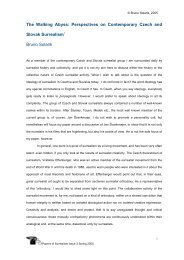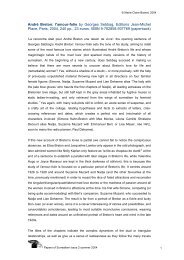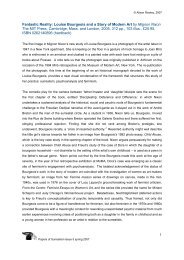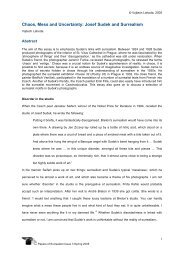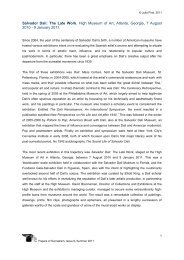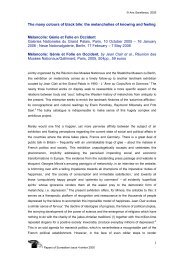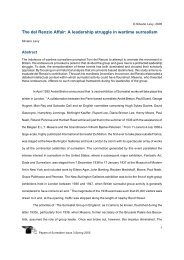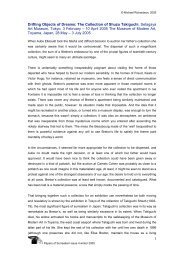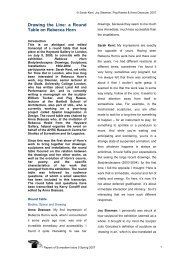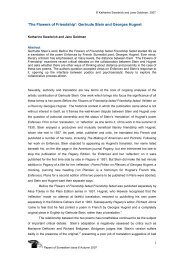From the Walls of Factories to the Poetry of the Street: Inscriptions ...
From the Walls of Factories to the Poetry of the Street: Inscriptions ...
From the Walls of Factories to the Poetry of the Street: Inscriptions ...
You also want an ePaper? Increase the reach of your titles
YUMPU automatically turns print PDFs into web optimized ePapers that Google loves.
© Caroline Levitt, 2011<br />
difference all <strong>the</strong> same, on account <strong>of</strong> <strong>the</strong> grating sound <strong>of</strong> a key turning in a lock, or <strong>the</strong> wretched<br />
view <strong>of</strong> <strong>the</strong> garden, <strong>the</strong> cheek <strong>of</strong> <strong>the</strong> people who question you when you don‟t want <strong>the</strong>m <strong>to</strong>.‟ 17 Bre<strong>to</strong>n<br />
aligns <strong>the</strong> deprivation <strong>of</strong> freedom with madness itself, seeing it not as a cure but as something <strong>to</strong> be<br />
overcome.<br />
If <strong>the</strong> surrealists were, for <strong>the</strong> most part, locked in social and mental constraints ra<strong>the</strong>r than<br />
physical ones, one <strong>of</strong> <strong>the</strong>ir particular heroes, <strong>the</strong> Marquis de Sade, had been subject <strong>to</strong> extensive<br />
physical imprisonment and had found a source <strong>of</strong> freedom in his subversive writing. In 1909, <strong>the</strong><br />
same year as L’Enchanteur appeared, Apollinaire published an edition <strong>of</strong> <strong>the</strong> works <strong>of</strong> <strong>the</strong> Marquis de<br />
Sade. In his preface, he explained that Sade had spent twenty-seven years <strong>of</strong> his life in eleven<br />
different prisons, had died in <strong>the</strong> asylum <strong>of</strong> Charen<strong>to</strong>n and had his books banished <strong>to</strong> <strong>the</strong> enfer<br />
(„underworld‟) <strong>of</strong> <strong>the</strong> Bibliothèque nationale. Yet, he claimed, Sade loved freedom above all else and<br />
was „<strong>the</strong> freest [spirit] that ever lived.‟ 18 Sexual perversions and dis<strong>to</strong>rted morality characterise Sade‟s<br />
writing, and Apollinaire summarised Justine and Juliette, two <strong>of</strong> <strong>the</strong> s<strong>to</strong>ries included in <strong>the</strong> volume he<br />
edited, by quoting one <strong>of</strong> Juliette‟s lines: „I have followed <strong>the</strong> route <strong>of</strong> vice, my child, and I have never<br />
met with anything except roses.‟ 19 Such an inversion <strong>of</strong> morality, a parody <strong>of</strong> society‟s hypocritical<br />
values, was both a fundamental element <strong>of</strong> Sade‟s appeal <strong>to</strong> Apollinaire and <strong>the</strong> surrealists, and <strong>the</strong><br />
reason for which Apollinaire described him as „free‟ in spite <strong>of</strong> <strong>the</strong> censorship and imprisonment<br />
imposed on him: a society mocked by its victims can only ever, Apollinaire suggests, be shown <strong>to</strong> be<br />
weak, demonstrating, conversely, its victims <strong>to</strong> be in a position <strong>of</strong> power and consequently <strong>of</strong><br />
freedom.<br />
Transgression <strong>of</strong> a Sadean nature is linked <strong>to</strong> graffiti in a little-known short s<strong>to</strong>ry by<br />
Apollinaire, set not in <strong>the</strong> streets <strong>of</strong> Paris this time, but in an underground cave in <strong>the</strong> forest. On his<br />
way <strong>to</strong> Werp, <strong>the</strong> narra<strong>to</strong>r <strong>of</strong> „Le Roi-Lune‟ („The Moon King‟) loses his way and decides <strong>to</strong> seek<br />
shelter from <strong>the</strong> wea<strong>the</strong>r and <strong>the</strong> dark in <strong>the</strong> entrance <strong>to</strong> a cave. 20 On hearing music, he goes fur<strong>the</strong>r<br />
in and discovers a network <strong>of</strong> passageways and caverns, at <strong>the</strong> heart <strong>of</strong> which a banquet is taking<br />
place. Living food serves itself <strong>to</strong> <strong>the</strong> guests, who sit at tables without legs on inflatable rubber chairs,<br />
tended <strong>to</strong> by a Negro slave. 21 The banquet over, <strong>the</strong> lights are turned <strong>of</strong>f and <strong>the</strong> cave‟s inhabitants<br />
adjourn. The narra<strong>to</strong>r, following <strong>the</strong>ir voices, discovers „<strong>the</strong> most extraordinary obscene graffiti‟ on <strong>the</strong><br />
walls <strong>of</strong> a dark, narrow passageway. The various etchings parody <strong>the</strong> values <strong>of</strong> France‟s monarchy,<br />
<strong>the</strong> Catholic faith and artistic tradition. One phrase reads „I would like <strong>to</strong> make love <strong>to</strong> <strong>the</strong> abbess <strong>of</strong><br />
Gandersheim,‟ <strong>the</strong> Abbey <strong>of</strong> Gandersheim being a German convent from <strong>the</strong> Middle Ages, and<br />
ano<strong>the</strong>r „I want Madame de Pompadour,‟ <strong>the</strong> <strong>of</strong>ficial mistress <strong>of</strong> Louis XV. Elsewhere, Michelangelo is<br />
claimed <strong>to</strong> have „given great pleasure <strong>to</strong> Hans von Jagow,‟ and <strong>the</strong> words are supported with a<br />
drawing <strong>of</strong> an enormous phallus. 22 The techniques <strong>of</strong> <strong>the</strong> various inscriptions are described, some<br />
having been undertaken in pencil, o<strong>the</strong>rs in chalk or charcoal and o<strong>the</strong>rs scratched in<strong>to</strong> <strong>the</strong> surface <strong>of</strong><br />
<strong>the</strong> wall with a metal point. Pierced hearts, phalluses and winged Cupids make up „<strong>to</strong>ut un blason<br />
indécent et capricieux‟ (a whole indecent and capricious blazon), <strong>the</strong> graffiti body-parts subverting <strong>the</strong><br />
courtly, romantic blazon and making up a low, crude one that recalls <strong>the</strong> walls <strong>of</strong> <strong>the</strong> fac<strong>to</strong>ries that<br />
Brassaï wrote about.<br />
Papers <strong>of</strong> Surrealism, Issue 9, Summer 2011 5





